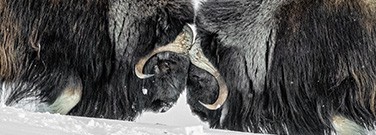Musk Oxen May Experience Brain Injuries, Too

By Kylie Wolfe
Scratch. Scratch. Charge! Large, hoofed musk oxen are known to run full speed at each other, knocking heads to establish dominance during mating season and within their herd. But by performing this instinctual activity, these thick-furred mammals, known scientifically as Ovibos moschatus, may be damaging their brains.
According to the Centers for Disease Control and Prevention, roughly 2.5 million people are admitted to the hospital for traumatic brain injuries each year. To help future doctors and patients, scientists from Mount Sinai’s Icahn School of Medicine studied three naturally deceased musk oxen to see what they could learn about brain injury. Their work was published in Acta Neuropathologica in May 2022.
Animal Habits
Musk oxen are covered in two layers of thick fur and adorned with horns that don’t stop growing as they age. Male horns will not only grow outward but expand inward. This forms a hard protective layer on their forehead known as a boss.
During mating season, male musk oxen will charge toward each other, reaching speeds of almost 40 miles per hour. Even though headbutting is a natural part of their existence, scientists believe musk oxen still run the risk of brain injury.
Brain Injury Insights
Researchers at Mount Sinai used immunohistochemistry, a lab method that checks for certain markers in tissue samples, to study thin slices of brain tissue from three musk oxen, four bighorn sheep, and two humans. Images showed clusters of tau, a protein associated with traumatic brain injuries, along the edges of the cerebral cortex.
These findings are similar to what’s seen in patients with chronic traumatic encephalopathy (CTE). Athletes who repeatedly hit their heads, especially former football players, have been found with clusters of the same protein, contributing to memory loss, emotional issues, and depression.
In this study, female musk oxen displayed more significant brain damage than male musk oxen. Females headbutt less often, but males are built to endure consistent clashes; their skulls are 300 percent heavier on average, plus they have stronger neck muscles and forehead fat pads for cushioning. Scientists also noted that the older musk oxen showed greater signs of damage than the middle-aged one.
Future Studies
While the team’s results point to signs of brain damage, more research must be done to definitively reach that conclusion. While one might assume that musk oxen can take a hit to the head without issue, that may not be the case after all.
Scientists not involved with the study do warn of its limitations, citing that the small sample number does not provide enough evidence. The results could simply be linked to natural aging and decline. Other skeptics want to see more data and think the idea is worth further exploration. Either way, musk oxen and other head-butting animals could help researchers understand a similar form of neurodegeneration in humans.
Discussion Questions
- How are these findings about musk oxen relevant to humans?
- What should scientists do differently during future studies to generate more conclusive results?